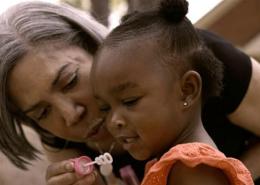Maintaining Positivity: A Mother and Daughter’s Perspective on Chronic Pain Due to Osteoarthritis

Ann Sullivan always tries to focus on the positive.
As someone who has been living with chronic pain due to knee osteoarthritis (OA) for more than 20 years, Ann has had to make adaptions to complete tasks in her day-to-day routine that most people may take for granted. Standing up after a long meeting requires time to “warm up” her knees before straightening them to stand; cooking long meals for holidays comes with consequences when her knee pain begins to set in after standing for such a long period of time; and, stepping down off of a curb always requires a helping hand from a family member to ensure she’s able to do so safely.
Though these compromises can occasionally be a point of frustration, Ann has always tried to maintain a positive attitude when managing her OA, not only for herself but also for her family.
In recognition of Pain Awareness Month, Ann and her daughter Elizabeth (Lizzie) Sullivan sat down with Grace Whiting, President and Chief Executive Officer of the National Alliance for Caregiving, to discuss the impact that chronic pain due to OA can have – not only on someone’s day-to-day activities, but also their relationships.
The Impact of Chronic Pain Due to Osteoarthritis
A progressive, degenerative joint disease, OA is the most common form of arthritis and a leading cause of chronic pain[1] – impacting approximately 27 million adults in the United States.[2] Chronic pain due to OA can affect many aspects of a person’s life,[3] and many people with OA lose the ability to function like they used to.[4]
Maintaining a Bond
There was never a defining moment when Lizzie realized her mom was dealing with chronic pain because of her OA, but she does remember sensing the frustration that Ann tried not to show when she was unable to do certain things she used to love.
“Our family loves to play tennis and that’s something I remember that she loved, and then I just remember her not doing it anymore,” said Lizzie. “Also, my family loves to travel and to hike, but she hasn't been able to go with us on those longer hikes, which I know is really frustrating for her.”
But no matter the situation, Ann and Lizzie have always made it a priority to work together as a team and manage the impact of Ann’s chronic pain due to OA in a positive way.
“There’s really no other way to live.” Ann says, “You have to be positive. You can’t be successful if you’re not positive. So, you have to put the pain in a box that you can deal with, but not let it pervade your entire life or rule your life.”
Lizzie adds, “[The experience has] given me even more respect for her and really [shows] what resiliency looks like. I mean, it’s just shown me even more, especially as I’m older and I understand it more, what an absolutely incredible woman my mom is.”
You can learn more about OA and tips for managing arthritis pain atGetHealthyStayHealthy.com.
[1] Rice D, McNair P, Huysmans E, Letzen J, Finan P. Best evidence rehabilitation for chronic pain part 5: osteoarthritis. J Clin Med. 2019;8:1769.
[2] Lawrence RC, Felson DT, Helmick CG, et al. Estimates of the prevalence of arthritis and other rheumatic conditions in the United States, Part II. Arthritis Rheum. 2008;58(1):26-35.
[3] Hunter DJ, Schofield D, Callander E. The individual and socioeconomic impact of osteoarthritis. Nat Rev Rheumatol. 2014;10:437-441. doi: 10.1038/nrrheum.2014.44.
[4] Neogi T. The epidemiology and impact of pain in osteoarthritis. Osteoarthritis Cartilage. 2013;21:1145-1153.
![]()





